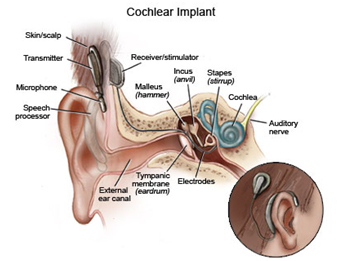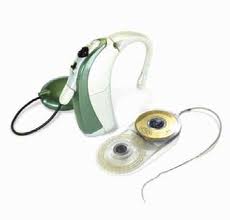|
What Is A Cochlear Implant?
A cochlear implant is a type of electronic device that works by converting accoustic sound waves into weak electrical currents, which are then delivered to the auditory nerve.It is designed to help profoundly deaf people who are beyond the help of convential hearing aid systems.With the implant, patients can gain awareness of enviromental sounds, speech or sometimes the telephone. Who gets cochlear implants ?Children and adults who are deaf or severely hard-of-hearing can be fitted for cochlear implants. According to the Food and Drug Administration (FDA), at the end of 2006, more than 112,000 people worldwide had received implants. In the United States, roughly 23,000 adults and 15,500 children have received them. Adults who have lost all or most of their hearing later in life often can benefit from cochlear implants. They learn to associate the signal provided by an implant with sounds they remember. This often provides recipients with the ability to understand speech solely by listening through the implant, without requiring any visual cues such as those provided by lipreading or sign language. Cochlear implants, coupled with intensive postimplantation therapy, can help young children to acquire speech, language, and social skills. Most children who receive implants are between two and six years old. Early implantation provides exposure to sounds that can be helpful during the critical period when children learn speech and language skills. In 2000, the FDA lowered the age of eligibility to 12 months for one type of cochlear implant.
See what a cochlear implants looks like on video. EquipmentThere are many types of cochlear implant available, from single channel to multi-channel systems.However, they share basic components. Essentially a cochlear implant has two parts: one worn externally and the other internally, implanted under the skin. Externally, a patient has to wear a microphone, a speech processor (rather like a hearing aid) and a post auraltransmitter placed over the internal receiver. The transmitter and procesor are linked via a wire or cable. Internally a receiver stimulator is buried under the skin behind the ear, visible only as a small bump. Single channel implants involve placing an electrode from the receiver on the round window of the cochlea.This is known as an extra-cochlear implant. Multi channel implants are placed into the cochlea and signals passing down the cable from the receiver are carried to the relevant nerve fibres.The implants are designed to last a lifetime, but being a man-made device there is some chance of failure. In such cases (1%) the implanted part of the device can be replaced surgically. A cochlear implant is very different from a hearing aid. Hearing aids amplify sounds so they may be detected by damaged ears. Cochlear implants bypass damaged portions of the ear and directly stimulate the auditory nerve. Signals generated by the implant are sent by way of the auditory nerve to the brain, which recognizes the signals as sound. Hearing through a cochlear implant is different from normal hearing and takes time to learn or relearn. However, it allows many people to recognize warning signals, understand other sounds in the environment, and enjoy a conversation in person or by telephone. Evaluation ProcessThe major preoperative selection criteria are: 1.Profound bilateral sensorineural hearing loss. 2.Proof or no demonstrable benefit from optimally fitted hearing instruments. 3.No medical contraindications 4.High motivation and appropriate expectations.
The ProcedureIf the audiological tests indicate that the patient may be a candidate, medical tests will be performed. CT scans are taken to see if the cochlea is suitable for implant. A test can be peeformed to determine if electrical stimulation to the hearing nerve is feasible.Tests are also performed to ensure that the patient can successfully undergo anaesthesia and surgery. The OperationThe operation involves a mastoidectomy by the post-aural route in order to creat a cavity for the receiver stimulator in the mastoid bone. Also a posterior tympanotomy ( an operation to expose the middle ear) is carried out in order to access the middle ear cavity and the round window through which the micro-cables with the electrodes is inserted in the cochlea. The operation takes approximately 2 hours with a stay in hospital of 1-2 days. The implant will not work until the patient receives the external parts of the implant, during "switch on" which usually takes place about 6 weeks after the operation. Rehabilitation and AssessmentAn audiological scientist, hearing therapist, (teacher for the deaf) and a speech and language therapist carry out the rehabilition and assesment programme. Cochlea Implant ForumHearing Journey is the place to chat, laugh, and share stories about cochlear implants and hearing loss. Join today, say hello, and receive a warm welcome from this lively group Cochlear Implant BatteriesDiscover batteries designed specifically to meet the needs of patients with cochlear implants.
Rayovac Cochlear Plus
meets the high-power demands required by cochlear implants in a 60-pack carton in size 675.
|








